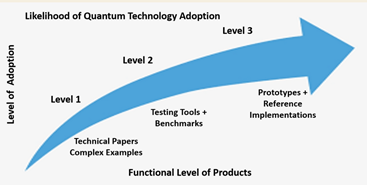QED-C is excited to feature the first TAC blog, from the Chair of the Standards TAC Tom Lubinski. Tom offers a glimpse at the TAC’s beginnings, what the TAC members have worked on and where they’re going.
Look for updates from other TACs in the future.
Celia Merzbacher, QED-C Deputy Director
>>>>>>>>>>>>>>>>>>>>>>>>>>>>>>>>>>>>>
From the Standards TAC Chair:
So, why did we become members of QED-C, anyway?
Most of us saw it as an opportunity – a group of smart people from like-minded companies and other stakeholders get together to figure out how to stimulate economic development in Quantum Technologies … sounds interesting, right? We were welcomed to QED-C — but now that we are here, what do we actually do? How does one get value?
I attended the first QED-C plenary meeting over two years ago (the in-person meetings, if you can recall those) during which the Technical Advisory Committees (TACs) were formed. These are where much of the action happens in QED-C. Members were asked to choose one of the four corners of the room where each TAC would assemble. The “Standards” TAC had the smallest crowd, so I headed that way. I left that day as the Chair of the committee, thinking to myself, “Great, what do we do now?”
The initial charter for the Standards TAC was to “study and report on the standards landscape”. We got started on that, but it didn’t take very long… we quickly found there wasn’t much of a landscape to study! It’s too early for standards, we’re too busy building hardware to work on standards, someone else will do that, and so on… A few standards development organizations (SDOs) have projects started, some having made progress, but most are still in the early stages.
We had to go back to the drawing board. How can we use this unique opportunity to do something to really advance the cause? It became clear that we needed to think and talk about “standards” more broadly. Perhaps we should also consider “benchmarks” or other performance metrics, not just “standards”?
We determined that our aim should be about removing the friction and obstacles to adoption of new and rapidly evolving quantum technologies. The Developers of Quantum Solutions know the technology inside and out and share information via technical documents. The Users of Quantum Solutions need more… they need ready-to-use, hands-on tooling and reference implementations. As shown in the diagram below, adoption of technology is far more likely when concrete solutions are made available.

There is a wealth of literature that describes in detail the intricacies of the technology, techniques for characterizing or bench-marking quantum components and higher-level systems. But for the average “new user” who may be highly capable, but steeped in a field other than quantum science, a lot of this is out of reach and may not be relevant to their needs.
Our goal in the Standards TAC is to find ways to remove the obstacles that limit adoption. It may be as simple as getting the Quantum Solution Developers “on the same page” and “speaking the same language”, or at least being able to understand one another. The hope is that they will create for Quantum Solution Users products that are quick to absorb and easy to use, with fewer choices to be made.
We found that there is a great appetite for tools or examples that can help “jump start” a new user’s exploration of the technology. Often the first thing they want to do is run quick tests and compare solutions offered by multiple providers. Forcing them to develop even simple test suites or benchmarks on their own is a major hindrance to such exploration and ultimate adoption.
To this end, the TAC has initiated and is actively engaged in a number of concrete projects that attempt to identify testing tools and reference implementations to aid in learning and adoption. Projects around Quantum Network Device Certification, Prototype Benchmarks for Quantum Computing, and a study on Standards Readiness Levels have gained a lot of attention and are producing tangible results.
True “standards” will emerge as the technology matures. For now, “standard ways of doing things” can make life easier for developers and users alike!
As a service to the rest of QED-C, the Standards TAC has produced a number of documents that capture its findings and record its work to date. Some of that content is posted on the QED-C member web site in the Standards TAC section on Projects & Reports, including summaries of various standards development activities underway at SDOs worldwide.
Metrics, benchmarks and eventually standards are essential to the development and commercialization of new technologies. Almost every QED-C member will need/benefit from standards and at a minimum should monitor their development. At present, sound benchmarks can help measurement of progress and comparison among products.
We strongly encourage you to take advantage of the work that has been done and the materials created so far. Even more so, the Standards TAC (and other TACs as well) seeks your active involvement in these committee projects. What you get out of your involvement with QED-C will depend a lot on your direct participation in some of these efforts. As for me, I had a limited appreciation for the importance of standards, but I have come to recognize its many dimensions and the significant role they play in technology adoption.
Note: this is the first in what will be a series of informative blogs put out by the QED-C Standards TAC. Stay tuned!
Tom Lubinski
Chair, Standards and Performance Metrics TAC

